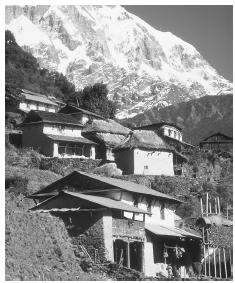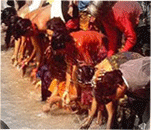Nepal is named for the Kathmandu Valley, where the nation's founder established a capital in the late eighteenth century. Nepali culture represents a fusion of Indo-Aryan and Tibeto-Mongolian influences, the result of a long history of migration, conquest, and trade. Nepal is a roughly rectangular country with an area of 147,181 square miles (381,200 square kilometers). To the south, west, and east it is bordered by Indian states; to the north lies Tibet. Nepal is home to the Himalayan Mountains, including Mount Everest. From the summit of Everest, the topography plunges to just above sea level at the Gangetic Plain on the southern border. This drop divides the country into three horizontal zones: the high mountains, the lush central hills, and the flat, arid Terai region in the south. Fast-moving, snow-fed rivers cut through the hills and mountains from north to south, carving deep valleys and steep ridges. The rugged topography has created numerous ecological niches to which different ethnic groups have adapted. Although trade has brought distinct ethnic groups into contact, the geography has created diversity in language and subsistence practices. The result is a country with over thirty-six ethnic groups and over fifty languages. The population in 1997 was just over 22.6 million. Although infant mortality rates are extremely high, fertility rates are higher. High birth rates in rural areas have led to land shortages, forcing immigration to the Terai, where farmland is more plentiful, and to urban areas, where jobs are available. Migration into cities has led to over-crowding and pollution. The Kathmandu Valley has a population of approximately 700,000. After conquering much of the territory that constitutes modern Nepal, King Prithvi Narayan Shah (1743–1775) established Gorkhali (Nepali) as the national language. Nepali is an Indo-European language derived from Sanskrit with which it shares and most residents speak at least some Nepali, which is the medium of government, education, and most radio and television broadcasts. For many people Nepali is secondary to the language of their ethnic group or region. This situation puts certain groups at a disadvantage in terms of education and civil service positions. Since the institution of a multiparty democracy in 1990, linguistic issues have emerged as hotly debated topics.
The culture has many symbols from Hindu and Buddhist sources. Auspicious signs, including the ancient Hindu swastika and Shiva's trident, decorate buses, trucks, and walls. Other significant symbols are the emblems (tree, plow, sun) used to designate political parties. Prominent among symbols for the nation as a whole are the national flower and bird, the rhododendron and danfe; the flag; the plumed crown worn by the kings; and the crossed kukhris (curved knives) of the Gurkhas, mercenary regiments that have fought for the British Army in a number of wars. Images of the current monarch and the royal family are displayed in many homes and places of business. In nationalistic rhetoric the metaphor of a garden with many different kinds of flowers is used to symbolize national unity amid cultural diversity.
To unify a geographically and culturally divided land, Shah perpetuated the culture and language of high-caste Hindus and instituted a social hierarchy in which non-Hindus as well as Hindus were ranked according to caste-based principles. Caste laws were further articulated in the National Code of 1854. By privileging the language and culture of high-caste Hindus, the state has marginalized non-Hindu and low-caste groups. Resentment in recent years has led to the organization of ethnopolitical parties, agitation for minority rights, and talk about the formation of a separate state for Mongolian ethnic groups. Despite ethnic unrest, Nepalis have a strong sense of national identity and pride. Sacred Hindu and Buddhist sites and the spectacular mountains draw tourists and pilgrims and give citizens a sense of importance in the world. Other natural resources, such as rivers and flora and fauna are a source of national pride. The population consists of numerous racial, cultural, and linguistic groups that often are divided into three broad categories: Indo-Nepalese, Tibeto-Nepalese, and indigenous Nepalese. The Indo-Nepalese migrated from India over several

Hindu castes and Buddhist and animist ethnic groups were historically collapsed into a single caste hierarchy. At the top are high-caste Hindus. Below them are alcohol-drinking ( matwali ) castes, which include Mongolian ethnic groups. At the bottom are untouchable Hindu castes that have traditionally performed occupations considered defiling by higher castes. The Newars of the Kathmandu Valley have a caste system that has been absorbed into the national caste hierarchy.
Historically, members of the highest castes have owned the majority of land and enjoyed the greatest political and economic privileges. Members of lower castes have been excluded from political representation and economic opportunities. The untouchable castes were not permitted to own land, and their civil liberties were circumscribed by law. Caste discrimination is officially illegal but has not disappeared. In 1991, 80 percent of positions in the civil service, army, and police were occupied by members of the two highest castes.
The majority of commercial activity takes place at small, family-owned shops or in the stalls of sidewalk vendors. With the exception of locally grown fruits and vegetables, many products are imported from India and, to a lesser extent, China and the West. Jute, sugar, cigarettes, beer, matches, shoes, chemicals, cement, and bricks are produced locally. Carpet and garment manufacturing has increased significantly, providing foreign exchange. Since the late 1950s, tourism has increased rapidly; trekking, mountaineering, white-water rafting, and canoeing have drawn tourists from the West and other parts of Asia. The tourism industry has sparked the commercial production of crafts and souvenirs and created a number of service positions, such as trekking guides and porters. Tourism also has fueled the black market, where drugs are sold and foreign currency is exchanged. There was no industrial development until the middle of the twentieth century. Much of earliest industrial development was accomplished with the help of private entrepreneurs from India and foreign aid from the Soviet Union, China, and the West. Early development focused on the use of jute, sugar, and tea; modern industries include the manufacturing of brick, tile, and construction materials; paper making; grain processing; vegetable oil extraction; sugar refining; and the brewing of beer. Nepal is heavily dependent on trade from India and China. The large majority of imported goods pass through India. Transportation of goods is limited by the terrain. Although roads connect many major commercial centers, in much of the country goods are transported by porters and pack animals. The few roads are difficult to maintain and subject to landslides and flooding. Railroads in the southern flatlands connect many Terai cities to commercial centers in India but do not extend into the hills. Nepal's export goods include carpets, clothing, leather goods, jute, and grain. Tourism is another primary export commodity. Imports include gold, machinery and equipment, petroleum products, and fertilizers.
Nepal is blessed with one of the richest cultures in the world. Culture has been called 'the way of life for an entire society'. The statement holds particularly true in case of Nepal where every aspect of life, food, clothing and even occupations are culturally guided. The culture of Nepal includes the codes of manners, dress, language, rituals, norms of behavior and systems of belief.
Nepalese are among the most hospitable hosts. This is the reason for which tourists from far and wide enjoy coming to Nepal time and again. Local Nepalese are generally rural people who welcome the tourists to their homes for tea, coffee or supper. Nepalese are culturally warm, hospitable and affectionate hosts who place their heart above their head.

Nepal is also the Gateway to Kailash Mansarovar, the mythical abode of Lord Shiva. Devotees from various parts of Nepal and India throng the temples during special festivals. Even though weak infrastructure renders some places hard to reach, efforts are being made on national level to develop and promote some popular sites. Pilgrimage sites of Nepal like Muktinath and Gosainkunda make popular trekking destinations. Tours to these sites are encouraged for the novelty they provide in terms of nature and culture.

No comments:
Post a Comment